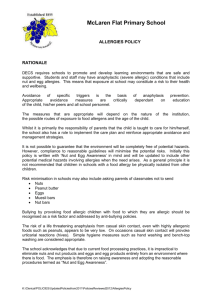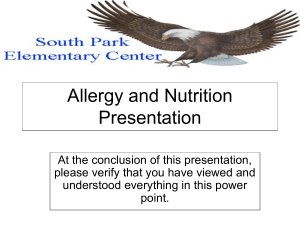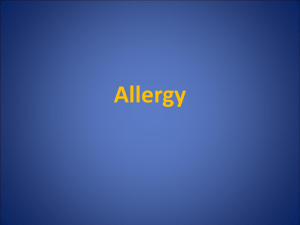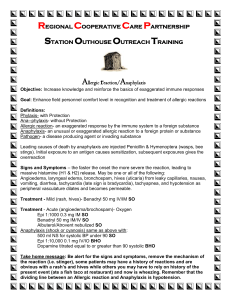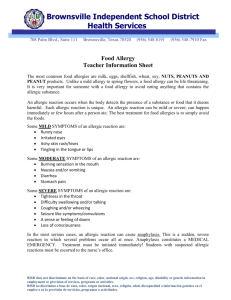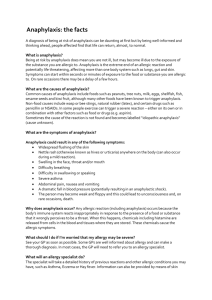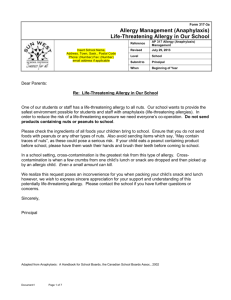Anaphylaxis & Food Allergy Policy
advertisement
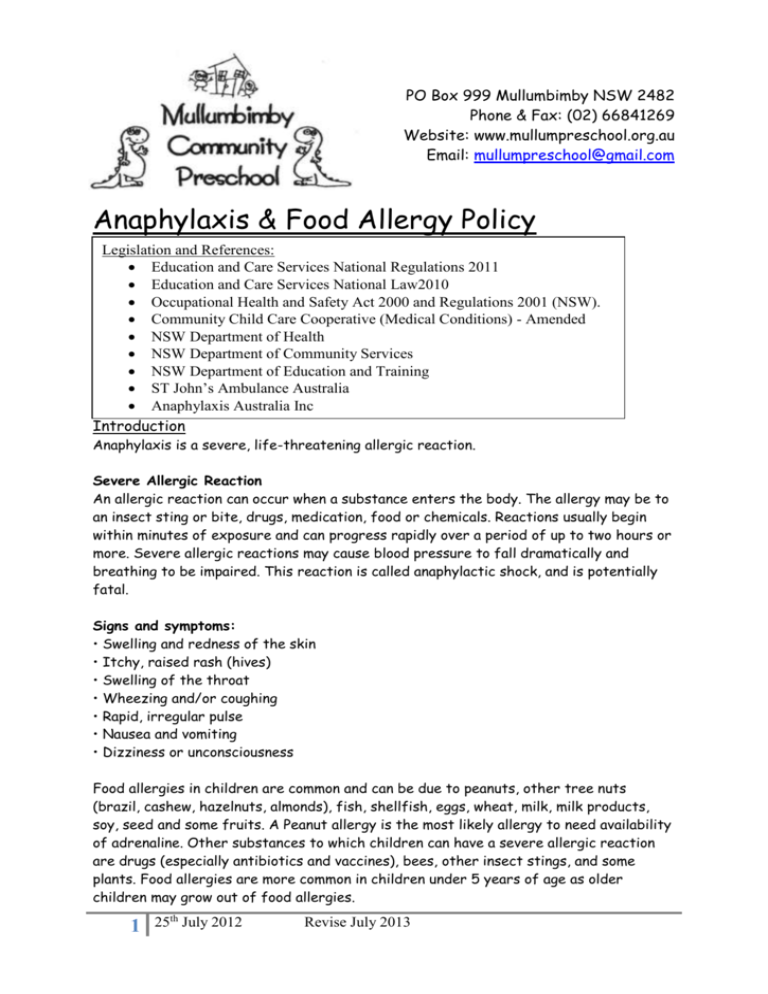
PO Box 999 Mullumbimby NSW 2482 Phone & Fax: (02) 66841269 Website: www.mullumpreschool.org.au Email: mullumpreschool@gmail.com Anaphylaxis & Food Allergy Policy Legislation and References: Education and Care Services National Regulations 2011 Education and Care Services National Law2010 Occupational Health and Safety Act 2000 and Regulations 2001 (NSW). Community Child Care Cooperative (Medical Conditions) - Amended NSW Department of Health NSW Department of Community Services NSW Department of Education and Training ST John’s Ambulance Australia Anaphylaxis Australia Inc Introduction Anaphylaxis is a severe, life-threatening allergic reaction. Severe Allergic Reaction An allergic reaction can occur when a substance enters the body. The allergy may be to an insect sting or bite, drugs, medication, food or chemicals. Reactions usually begin within minutes of exposure and can progress rapidly over a period of up to two hours or more. Severe allergic reactions may cause blood pressure to fall dramatically and breathing to be impaired. This reaction is called anaphylactic shock, and is potentially fatal. Signs and symptoms: • Swelling and redness of the skin • Itchy, raised rash (hives) • Swelling of the throat • Wheezing and/or coughing • Rapid, irregular pulse • Nausea and vomiting • Dizziness or unconsciousness Food allergies in children are common and can be due to peanuts, other tree nuts (brazil, cashew, hazelnuts, almonds), fish, shellfish, eggs, wheat, milk, milk products, soy, seed and some fruits. A Peanut allergy is the most likely allergy to need availability of adrenaline. Other substances to which children can have a severe allergic reaction are drugs (especially antibiotics and vaccines), bees, other insect stings, and some plants. Food allergies are more common in children under 5 years of age as older children may grow out of food allergies. 1 25th July 2012 Revise July 2013 Goals Mullumbimby Preschool will facilitate effective care, health management and management of emergencies in children who have food allergies, and children who are at risk of anaphylaxis. Mullumbimby Preschool will minimise the risk of exposure of children to foods and other substances, which might trigger severe allergy or anaphylaxis in susceptible children Strategies/Practices To facilitate effective care and management of anaphylaxis or other emergencies in a child with food allergies or susceptibility to anaphylaxis, staff will: Ensure families provide information on the child’s health, medications, allergies, their doctor’s name, address and phone number, emergency contact names and phone numbers, and an Anaphylaxis First Aid Plan or Emergency Medical Plan approved by their doctor following enrolment and prior to the child starting at the service. Ensure families provide documentation from their doctor confirming their child’s allergies and their management in the form of an Allergy Emergency Medical Plan. Ensure all staff are aware of children that have allergies and what they are allergic to prior to the children starting at the service. Ensure Regulation and other Guidelines are adhered to in respect of administering medication and treatment in emergencies, particularly parental or guardian written consent and a Medication Authority Form has been completed and signed. In any case where a child is having a severe allergic reaction or any symptoms or signs of anaphylaxis, the children’s centre staff or centre manager should immediately: administer first aid or medical treatment according to either: - the child’s Anaphylaxis First Aid or Emergency Medical Plan, or, - a doctor’s instructions, or, - if a child care staff member who has undergone training by an appropriate health or first aid organisation in the management of anaphylaxis and/or the administration of adrenaline (EpiPen or EpiPen Jr) is present at the time, the Anaphylaxis Action Plan as recommended by that training, or, - if these are not available, use the First Aid Plan for Severe Allergic Reaction from Australian First Aid, St John Ambulance Australia, 2002, and, dial 000 for an ambulance and notify the families in accordance with the Regulation and guidelines on emergency procedures If a centre staff member is to be responsible for the emergency administration of adrenaline (EpiPen or EpiPen Jr) to a child with anaphylaxis, this should be by prior written agreement between the centre, children’s centre staff and child's parent or guardian, and with written consent from the parent or guardian, and under the following conditions: - it is a requirement of and included in the child's Emergency Management Plan, 2 25th July 2012 Revise July 2013 - the parent or guardian has provided the appropriate authorisation and consent and understands their responsibilities under the Regulation and these Guidelines, - the parent or guardian understands and acknowledges any potential risks or side effects of the administration of adrenaline to their child, - the children’s centre staff member has been adequately trained by an appropriate organisation in the administration of adrenaline and use of the EpiPen and the safe disposal of contaminated material, the children’s centre staff member feels they are confident and competent to administer the medication, - the parent or guardian understands that the centre staff member who has been specifically trained to administer adrenaline may not always be present in the centre when an emergency occurs, and in that case, the centre will implement their emergency procedures and first aid plan. To minimise the risk of exposure of children to foods that might trigger severe allergy or anaphylaxis in susceptible children, Mullumbimby Community Preschool will: Ensure children do not trade or share food, food utensils and food containers. Be aware that allergy in children can be triggered in the following ways – contact through ingestion, inhalation of a dust or vapor, skin contact, or a bite or sting. Be aware that allergies are very specific to the individual and it is possible to have an allergy to any foreign substance. Where possible, ensure all children with food allergies only eat food and snacks that have been prepared for them at home. Ensure food preparation, food serving, and relief staff are informed of children and staff who have food allergies, the type of allergies they have, and the centre’s procedures for dealing with emergencies involving allergies and anaphylaxis. Restrict the use of foods likely to cause allergy in craft and cooking play. In preparing food, prevent cross-contamination between foods, food surfaces and utensils, particularly when preparing foods containing the most likely allergens such nuts, milk and milk products, eggs and egg products, and soy. Where a child is known to have a susceptibility to severe allergy or anaphylaxis to a particular food, have a “food free policy” for that particular food, e.g. a “Nut Free Policy”, which would exclude children or other people visiting the centre from bringing any foods containing nuts or nut products such as : - peanuts, brazil nuts, cashew nuts, hazelnuts, almonds, pecan nuts - any other type of tree or ground nuts, peanut oil or other nut based oil or cooking product, peanut or any nut sauce, peanut butter, hazelnut spread, marzipan - any other food which contains nuts such as chocolates, sweets, lollies, nougat, ice creams, cakes, biscuits, bread, drinks, satays, pre-prepared Asian or vegetarian foods - foods with spices and seeds such as mustard, poppy, wheat and sesame seeds - nut and peanut material is also often in cosmetics, massage oils, body lotions, shampoos and creams such as Arachnis oil. Be aware that a child may have a number of food allergies or there may be a number of children with different food allergies, and it may not be possible to have 3 25th July 2012 Revise July 2013 an allergy free policy for all those foods involved. Nut allergy is the most likely to cause severe reaction and should take precedence. If displaying personal information about children’s or staff member’s allergies in food preparation or serving areas, do so in accordance with privacy guidelines, such as displaying in an area accessible to staff and not accessible to visitors or other families. Explain to families the need to do so for purpose of safety of the child and obtain parental consent. Ensure children identified as allergic to specific triggers and substances do not have access to or contact with those substances. Other common groups of substances which can trigger allergic reaction or anaphylaxis in susceptible children include: - all types of animals, insects, spiders and reptiles - all drugs and medications, especially antibiotics and vaccines - many homeopathic, naturopathic and vitamin preparations Evaluation 4 25th July 2012 Revise July 2013

